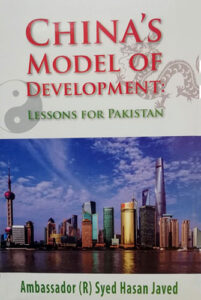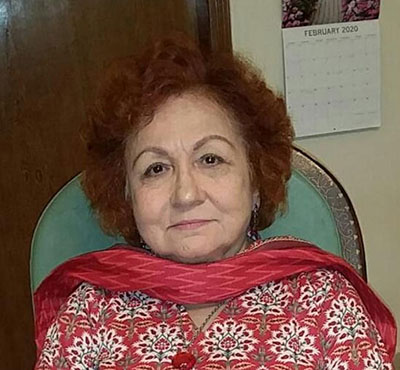
Author: Syed Hasan Javed Publisher: New Fakhri Printing Press, Karachi 2020
Pages: 322
Price: Rs 1200
In his latest book, China’s Model of Development: Lessons for Pakistan, Ambassador (R) Syed Hasan Javed starts off with a discussion on the origins of the Chinese civilisation and goes on to discuss the evolution of the State from its centrally planned character during 1949-1979, the challenges and the problems encountered, and the turmoil of the Cultural Revolution. The author goes on to note that “Deng Xiaoping’s comeback in 1978 proved to be the single most important event of contemporary Chinese history, no less significant than the founding of the People’s Republic of China itself in 1949.” The new leadership gradually reversed state control of the economy and promoted private investments to lay the foundations of a market economy. It appears that prior to 1979, Chinese culture was somewhat similar to the Pakistani culture of hero worship and personality cult. But Premier Deng Xiaoping promoted Collective Leadership. He and his team of reformers built China around ‘perpetual reforms’ rather than ‘perpetual revolution.’
Economic reforms based on the free-market principles, introduced in 1979, were carried out in two stages. The first stage, from the late 1970s to the early 1980s, entailed de-collectivisation of agriculture, opening up the economy to foreign investment, and permission to entrepreneurs to start businesses. But most industries were still under state control. The second stage from the late 1980s to the 1990s brought privatisation, lifting of price controls, protection and regulation, while state monopolies in banking and petroleum remained. But these structural reforms were not International Financial Institutions (IFIs)-driven, but home-grown, based on comparative advantage, creation of industrial parks and special economic zones. The author notes that since the beginning of Deng Xiaoping’s reforms, China’s GDP (Gross Domestic Product) rose tenfold, with 40 percent of this attributable to Total Factor Productivity (TFP). Per capita incomes grew by 6.6 percent per year, average wages rising six-fold between 1978 and 2005 and absolute poverty declined from 41 percent to 5 percent of the population between 1978 to 2001. Ambassador Javed discusses China’s very successful poverty-alleviation programme. In 1979, 89 percent of China’s population lived below the poverty line, earning $2 per day. The percentage declined to 30 million in 2018 and the target for 2020 was zero. This was mainly through Deng Xiaoping’s philosophy of wealth creation, as against the policy of poverty-redistribution in the 1949-79 era. Millions of people were lifted out of poverty by focusing on agriculture and rural industrialisation. This was part of the Four-Point Modernisation programme, starting with agriculture, industry, science and technology and defence — in that order.
In this programme the topmost priority was accorded to agriculture. The farmers were allowed to keep agricultural output after paying a certain quota to the state, and sell the surplus at the market price. This increased agricultural production raised the living standards of millions of farmers. The Agriculture Household Responsibility System allowed the farmers to grow crops, vegetables and flowers and sell them in the free market, after paying the government quota. As a result of this system, agriculture released surplus labour, which was absorbed in Township Village Enterprises, which were small-scale consumer and light industrial products, initially for the home market and eventually for the export market. Reforms to increase industrial productivity were also introduced.
Promotion of science and technology resulted in more than 400 science and technology parks in 2020 in China, compared to 150 in the US, 15 in India and one in Pakistan. China also has the largest network of bullet trains, with the same distance covered in three hours as compared to 22 hours in the US. China increased its R&D (Research and Development) investments at the average rate of 19.5 percent between 2003 and 2013, far ahead of the US. In renewable energy, China made 300,000 patent applications as of 2020, compared to 150,000 by the US and 75000 each by Germany and Japan. In the defence arena, the PLA (People’s Liberation Army) established its companies for export and import businesses in products and services, including construction, infrastructure, roads, bridges, railways and port development. Some of these grew into giants like Norinco, Poly Technologies, Great Wall, Avic, Catic, etc. This enabled China to earn the much needed foreign exchange for modernisation and development.
On the political side, the focus was on establishing the rule of law, freedom, basic individual rights and mobilisation of overseas Chinese. Following a developmentalist-state model, China provided incentives to generate economic growth and rewarded bureaucrats for promoting investments. The Chinese economy thus experienced virtuous cycles with high investments promoting growth and high growth promoting high investments.
The Chinese reformed their civil service by cutting down the size of the bureaucracy, thus reducing red tape. These reforms were a combination of perks, privileges, promotions, penalties and punishments. While the size of the civil servants was reduced four times, their salaries and benefits were increased four times. Ambassador Javed notes that this is how China transformed its very large and inefficient bureaucracy into a lean and productive force, ready to take on the gigantic task of reconstruction and development. The legal and justice system was also revamped, with 90 percent cases decided at the middle- and lower-level.
Numerous Confucian qualities of leadership are discussed in the book, but the one I found very useful for Pakistan is that the Chinese did not look for celebrities with charisma, when picking their leaders; the Confucian philosophy enjoins upon you to look for substance. This brings out the shallowness in our criteria for the selection of leaders. The author goes on to discuss Confucian qualities of civil servants and Confucian rules of governance. Confucian rules of governance recognise that a country cannot have good governance without talented people. It states that “Good governance can be achieved by eradicating hypocrisy, bribery, luxury and disobedience.” The Chinese made merit the basis of selection, the size of the bureaucracy was reduced from 16 million in 1978 to 4 million in 2010 and 6 million in 2020. As the country moved from ‘Perpetual Revolution,’ to ‘Perpetual Reform,’ people were advised to move from being ‘aspiring soldiers’ to ‘aspiring entrepreneurs.’ The reformist leadership invested heavily in higher education by sending thousands of students annually to Western Europe and Japan in the 1980s, followed by several thousand annually to Canada, US and Australia.
What can Pakistan learn from this very successful model of development next door? Why have Pakistan and other developing countries not set their houses in order by following the Chinese path? Ambassador Javed himself answers this question. He says the rebellion of the farmers in Xiaogang, Anhui province in November 1978 could have erupted into a mass peasant uprising, but Deng Xiaoping saw it as an opportunity to usher in agricultural reforms and an open-door policy. He says many leaders in the developing world, I think Pakistan foremost among them, would have treated it as a law-and-order situation and used brute force to crush it.
When I compare the Belt-and-Road Initiative (BRI) with the present International Economic Order formulated by Europe and US, mainly Christians and Jews, one thing really strikes me. In the present world order, when there is a decline in economic activity in the rich countries as a result of the capitalist crisis, conflicts start brewing up in the developing world. These conflicts entail the purchase of arms, fighter planes, ammunition etc., thus increasing the GDP of armament-producing countries. So death and destruction of people in poor countries brings prosperity to the rich countries. And this order has been given to the world by those who believe in God and the hereafter. On the other hand, people who don’t believe in God and the hereafter have given an international economic order, which is so much more ethical, peaceful and development-oriented. It doesn’t inflict casualties on the poor countries in order to bring prosperity to rich countries. That is why it is called a ‘win-win model.’ This book is highly recommended to students of Development Economics, policy-makers, bureaucrats, and those trying to put their house in order and preparing leaders who can lead the gigantic task of development in their countries by emulating the Chinese success stories! Ambassador Javed has done his job of bringing the role played by the illustrious Chinese leader Deng Xiaoping to our attention. Hopefully, it will motivate those Pakistanis, who have the power to turn things around, to emulate the Chinese success stories in Pakistan!

The writer is the Dean of College of Economic & Social Development, IoBM.

